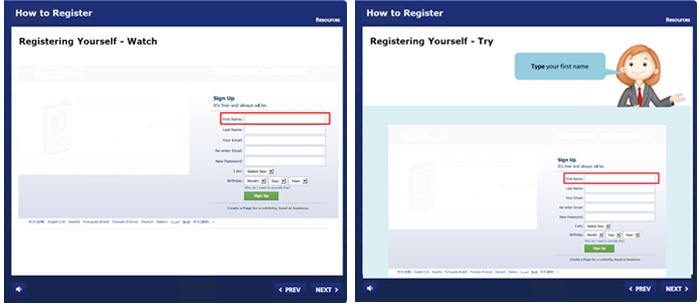Watch-Try-Do Methodology to Reinforce ERP End-User Training

ERP software training often requires hands-on practice, which is not possible in a traditional training program. In a traditional approach, trainers demonstrate how to use the software and how it works, but there is no chance for end-users to try out the software, learn how to avoid mistakes, and reinforce learning after go-live.
→ Download eBook: Become an eLearning Champion!
It is a common fact that, without practice and reinforcement, the information learned can be forgotten easily. So, how can you ensure that end-users get hands-on training on the software and reinforce their learning?
Using the ‘Watch-Try-Do’ methodology provides hand-on training on the software before go-live.
Wondering what this methodology is? Read on.
This is a three-step process where in the first step (Watch), we show end-users how the software application works; in the second step (Try), we allow him to try out the application in a virtual environment with some guidance (in the form of hints and pop ups); in the third step (Do), we ask the end-user to do it by himself. This approach works well for complex and tough to understand applications as it gives end-users opportunities to practice the software under guidance.
To view this three-step process. Click on the Watch, Try, Do options given in the image.
Now, let’s see why ‘Watch-Try-Do’ methodology for ERP end-user training.
It is a well-known fact that, most ERP software applications are very complicated for end-users to learn and understand. To help them understand the concept easily and remember the steps of executing the software for a longtime, they must be given opportunities to practice using the software.
The ‘Watch-Try-Do’ methodology provides effective hands-on practice in a zero-risk environment.

What are the benefits of the Watch-Try-Do methodology?
Reduces cost and saves time
The success of an ERP implementation depends on how well and quickly end-users adapt and use it at the workplace. The ‘Watch-Try- Do’ approach will reduce costs and save time by ensuring that end-users are properly trained on the complex steps by providing hands-on practice.
This approach will help them utilize the functionalities of the software properly, without committing any mistakes. Thus, it improves performance.

Become an eLearning Champion
A Practical Guide to eLearning Implementation
- Basics of eLearning and Recent Trends
- Role of Training in Achieving Business Results
- eLearning Design and Development Process
- And More!
Reduces risk
One small mistake in the ERP system may take a long time to rectify. The ‘Watch-Try-Do’ approach will help reduce the risk of errors in the process by ensuring maximum precision in the usage of the software application. This is because learners become familiar with the system by practicing it in a virtual, simulated environment.
Increases productivity
The success of an organization depends on high quality work. The ‘Watch-Try-Do’ approach will increase the productivity of end-users by providing an effective hands-on training.
Enhances performance
It is easy to make mistakes and learn from those mistakes in a virtual environment.
The ‘Watch-Try-Do’ approach will enhance the performance of an end-user by allowing him to identify where he went wrong and rectify it in a simulated environment.
This approach ensures that end-users will not repeat the same mistakes while working on the live software.
This is how the ‘Watch-Try-Do’ methodology reinforces ERP training by allowing end-users to practice the software before go-live.



![Reduce Learners’ Isolation through Translation – Check How [SlideShare]](https://blog.commlabindia.com/hubfs/Imported_Blog_Media/elearning-translation-reduce-learner-isolation.jpg)

